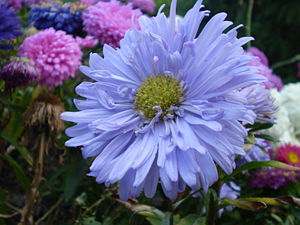Summer aster
| Summer aster | ||||||||||||
|---|---|---|---|---|---|---|---|---|---|---|---|---|

Summer aster varieties: inflorescence unfilled at the front, double inflorescences at the back |
||||||||||||
| Systematics | ||||||||||||
|
||||||||||||
| Scientific name of the genus | ||||||||||||
| Callistephus | ||||||||||||
| Cass. | ||||||||||||
| Scientific name of the species | ||||||||||||
| Callistephus chinensis | ||||||||||||
| ( L. ) Nees |
The summer aster ( Callistephus chinensis ) or garden aster is the only species of the genus Callistephus in the sunflower family (Asteraceae).
Another common German name for Bavaria is the term Todtenblume.
features
The summer aster is an annual herbaceous plant that reaches heights of 10 to 90 centimeters. The stem is erect, branched and coarsely hairy. The leaves are ovate-rhombic and roughly serrated, the lower ones are petiolate, the upper ones lanceolate to linear and sessile.
The cup-shaped inflorescences are individually at the end of the stem. In the flower heads are tongue (daisies) and disc florets (disc florets).
The flowering period extends from August to October.
The number of chromosomes is 2n = 18.
Occurrence
The summer aster occurs in Japan , Korea and China on the edges of deciduous forests. In China, it occurs in the provinces of Gansu , Hebei , Heilongjiang , Henan , Jiangsu , Jilin , Liaoning , Inner Mongolia , Shandong , Shanxi , Sichuan , Xinjiang and Yunnan . It grows there at altitudes between 300 and 2700 meters above sea level. As an ornamental plant, it thrives on fresh, nutrient-rich, loose, humus-rich soils in a warm, humid climate.
Taxonomy
The summer aster ( Callistephus chinensis (L.) Nees ) has the following synonyms: Aster chinensis L. , Callistemma chinense (L.) Skeels , Callistemma hortense Cass. and Callistephus hortensis (Cass.) Cass.
use
The summer aster is widely used as an ornamental plant for summer borders, flower beds and cottage gardens and as a cut flower. It has been in culture in Europe since 1728 at the latest. It has been cultivated in China for 2000 years. There are numerous varieties in around 9 groups of varieties:
- Margareten-Gruppe: The flower heads are unfilled, the plants spread through self-sowing and grow wild.
- Pinocchio group: the plants reach heights of up to 20 centimeters, the flower heads are filled, the ray-flowers are curved.
- Comet group: The early flowering plants reach heights of 15 to 25 centimeters, the flower heads are filled.
- Milady group: The plants reach heights of 20 to 30 centimeters.
- Ostrich feather group: The late flowering plants reach heights of up to 60 centimeters, the flower heads are filled and large.
- Compliment group: the plants reach heights of up to 70 centimeters, the flower heads are filled, the ray-flowers are rolled up.
- Prinzess-Gruppe: The plants reach heights of up to 75 centimeters, the crown of the disc flowers is long-tubular.
- Duchesse group: the plants reach heights of up to 70 centimeters, the flower heads are pompom-shaped.
- Pommax group: the plants reach heights of up to 70 centimeters, the cups have a diameter of up to 12 centimeters, the ray-flowers are spread apart.
supporting documents
- Eckehart J. Jäger, Friedrich Ebel, Peter Hanelt, Gerd K. Müller (eds.): Rothmaler excursion flora from Germany. Volume 5: Herbaceous ornamental and useful plants . Spectrum Academic Publishing House, Berlin Heidelberg 2008, ISBN 978-3-8274-0918-8 .
Individual evidence
- ^ Georg August Pritzel , Carl Jessen : The German folk names of plants. New contribution to the German linguistic treasure. Philipp Cohen, Hannover 1882, page 50, online.
- ↑ a b Erich Oberdorfer : Plant-sociological excursion flora for Germany and neighboring areas . With the collaboration of Angelika Schwabe and Theo Müller. 8th, heavily revised and expanded edition. Eugen Ulmer, Stuttgart (Hohenheim) 2001, ISBN 3-8001-3131-5 , pp. 912 .
- ^ A b Yilin Chen & Luc Brouillet: Callistephus Cassini. , Pp. 36-38 - online with the same text as the printed work , In: Wu Zheng-yi, Peter H. Raven, Deyuan Hong (ed.): Flora of China. Volume 20-21: Asteraceae. Science Press and Missouri Botanical Garden Press, Beijing and St. Louis 2010.
- ↑ a b Callistephus chinensis in the Germplasm Resources Information Network (GRIN), USDA , ARS , National Genetic Resources Program. National Germplasm Resources Laboratory, Beltsville, Maryland.
- ^ David John Mabberley: Mabberley's Plant-Book. A portable dictionary of plants, their classification and uses . 3rd ed. Cambridge University Press 2008. page 138. ISBN 978-0-521-82071-4
Web links
- Callistephus chinensis (L.) Nees, summer aster. In: FloraWeb.de.
- Summer aster . In: BiolFlor, the database of biological-ecological characteristics of the flora of Germany.
- Callistephus chinensis (L.) Nees In: Info Flora , the national data and information center for Swiss flora . Retrieved April 17, 2016.


